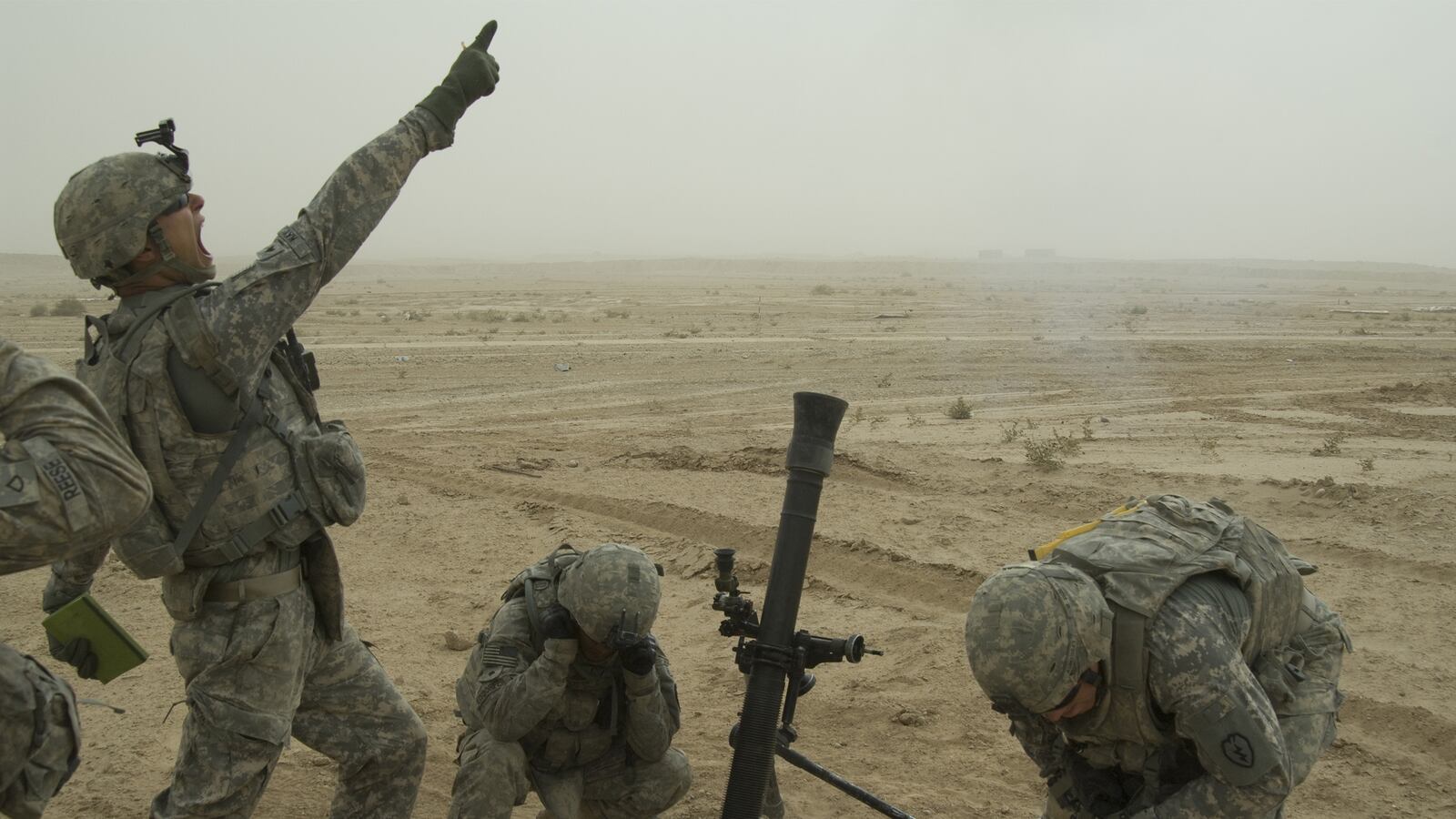In the war against the self-proclaimed Islamic State, there are two ways to count the number of U.S. boots on the ground. There’s the one that officials admit to. Then there’s the ground truth.
Officially, there are now 3,650 U.S. troops in Iraq, there primarily to help train the Iraqi national army.
But in reality, there are already about 4,450 U.S. troops in Iraq, plus another nearly 7,000 contractors supporting the American government’s operations. That includes almost 1,100 U.S. citizens working as military contractors, according to the latest Defense Department statistics.
In other words, the total number of forces that Pentagon and Obama administration officials frequently cite in public are wrong. They’re short thousands of contractors—and about 800 troops. These forces are often assigned to specialized units or tasked with supporting troops on the frontline.
Those short-term “support troops” could include security personnel or others maintaining base services. The official tally consists almost entirely of troops serving on the frontline alongside Iraqi forces.
“We create a variety of categories of troops,” the official explained.
In a war that began with the promise of no boots on the ground, the size of the U.S. footprint has become as important as the fighting itself. The Obama administration is committed to showing both the American and Iraqi public that the U.S. won’t be sending large numbers of ground forces back to the country, more than four years after that last soldiers officially engaged in combat departed.
But the true number of troops shows that the U.S. military presence is larger and growing faster than officials would like to admit.
Only after the number of troops reached the thousands did the administration acknowledge that boots were on the ground, but officials stressed they were not engaged in combat. Then, when Master Sgt. Joshua Wheeler was killed in a firefight last fall, officials said there were instances where troops would be in combat, but they still weren’t engaged in a combat mission.
But it’s become increasingly difficult to keep up that appearance. Last year, U.S. forces assisted as the Iraqi military and an elite counterterrorism unit took back the city of Ramadi from ISIS control. And now, they are eyeing a much larger and more complicated effort to retake the city of Mosul, which ISIS conquered in the summer of 2014.
“We’re looking for opportunities to do more and there will be boots on the ground and I want to be clear about that,” Secretary of Defense Ash Carter told CNBC last month. “But it’s a strategic question whether you are enabling local forces to take and hold rather than trying to substitute for them. That is a strategic intention that we have.”
Such semantics can make commanders reluctant to ask for more troops, critics argue. In a video briefing with reporters Monday, Lt. Gen. Sean MacFarland, commander of the American fight against ISIS, said he had been asked to draft plans to potentially expand the U.S. effort but quickly stressed that “doesn’t necessarily equate to boots the ground.”
“If you are a commander, you know you have to do with the troops you have,” Lawrence Korb, senior fellow at the Center for American Progress, told The Daily Beast.
Moreover, the risk that comes with serving in Iraq and Syria is not limited to those U.S. troops fighting ISIS day-to-day, Korb noted.
“Even if you are not on the frontline, you are in danger,” he said. “Unfortunately, when a contractor killed, people don’t care as much but they should.”
And the ranks of those contractors have expanded rapidly as more soldiers are sent to Iraq.
More than 1,400 contractors support Defense Department operations there, a nearly six-fold increase from December 2014, according to the U.S. military’s Central Command. About 1,100 of the contractors are American nationals.
Contractors perform a wide range of tasks, from construction to transportation, base support to administrative work. Thirty percent of them, the largest single group, provide logistics and maintenance support. There are also 306 contract translators and interpreters, making them the second-largest category of workers.
Security contractors make up only 6 percent of the total.
The number of contractors in Iraq is nowhere near as high as the almost 24,000 who were there when the last U.S. combat forces left the country, in December 2011. But the total number has been rising rapidly. In the spring of 2015, their ranks swelled from around 600 to about 1,350, roughly the level where they are today.
As of the last quarter of 2015, the most recent period for which there are figures available, there were approximately 6,850 contractors supporting all U.S. government operations in Iraq. Most of them work for the State Department. The intelligence agencies don’t disclose how many of their personnel are working in Iraq, contract or otherwise.
Throughout the U.S. wars in Iraq and Afghanistan since the terrorist attacks of Sept. 11, 2001, the size of the U.S. military presence in a country became one of the few tangible measures of success in wars that often has nebulous outcomes.
“By necessity you focus on the things you can count, which is the number of personnel on the ground,” Christopher Preble, vice president for defense and foreign policy studies at the Cato Institute, told The Daily Beast. But “do the numbers of people explain success or failure? No, they don’t. You could argue that it is sort of a distraction. The real way to measure is loss of territory and recruits and things like that, which may be completely independent of the number of forces on the ground.”
Such contorting of official figures is not limited to the war against ISIS. Officially, there are about 9,800 troops in Afghanistan, a politically palatable figure for an administration that once hoped to withdraw all U.S. forces.
Once specialized and support forces are added to that number, it grows to 12,300, according to Pentagon statistics. There are another 10,347 U.S. contractors.
But still, officials are reluctant to acknowledge the large numbers.
“We have never been closer to being under 10,000 troops,” one defense official told The Daily Beast.
In Afghanistan, too, the Pentagon frequently argues that the U.S. is not in a combat mission. Officials stressed that forces there were advisers even after six service members died in an attack Dec. 21.
More recently, in the war against ISIS and in Afghanistan, the U.S. has increased the numbers of Special Operations Forces. Such troops are harder to count and see, and sometimes not acknowledged at all. Last month, for example, the U.S. military was forced to acknowledge it had Special Forces in Libya only after others identified them.
In both Iraq and Afghanistan, the difference between the actual number and the one officials usually cite is about 20 percent, not enough to fundamentally change the war but an important political distinction nonetheless, Korb said.
“Realistically, the difference doesn’t matter,” Korb said. There’s no indication that the U.S. will be sending tens of thousands more troops to either country again. But, Korb added, “Symbolically and politically, it sends a message.”







